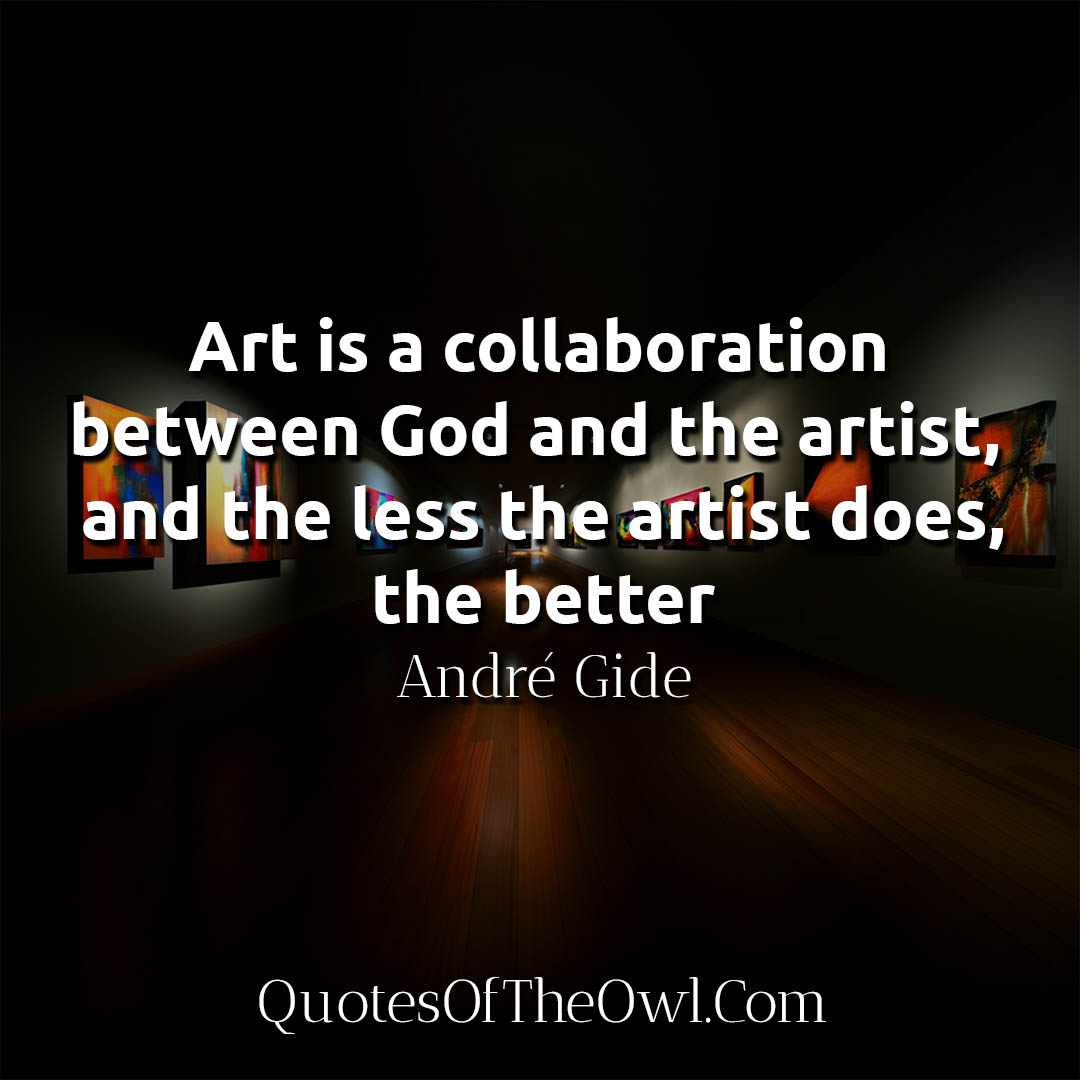Discover the Profound Meaning behind André Gide’s Quote: “Art is a collaboration between God and the artist, and the less the artist does, the better”
Art, in its most transcendent form, is a bridge between human expression and the divine. André Gide’s quote, “Art is a collaboration between God and the artist, and the less the artist does, the better,” captures the profound essence of this timeless relationship. Gide’s words have stirred intellectuals, artists, and thinkers for decades, sparking dialogue on creativity, spirituality, and the human condition. Here, we delve deeply into the meaning of this iconic statement, exploring the intricate dynamics of artistic inspiration and its connection with the divine force.
The Artist’s Role in the Creative Process
At the heart of Gide’s quote is the acknowledgment that art often transcends human effort alone. When Gide speaks of “the less the artist does,” he refers not to laziness or passivity, but to the relinquishing of control. The artist, in this context, is a vessel, a medium through which inspiration flows. True art emerges when the ego steps aside, allowing a higher, unrestrained creative energy to manifest. This approach invites the idea that artistic creation is not merely an individual act but one influenced by something greater, perhaps a spiritual or divine force.
This concept is not unique to Gide. Throughout history, many artists and philosophers have echoed this sentiment. For example, Rainer Maria Rilke spoke of writing as a “gift” that comes from outside oneself, while Leonardo da Vinci believed that painting was a spiritual endeavor. Such perspectives highlight the humility needed for genuine artistic expression.
Collaboration with the Divine
Gide’s use of the word “collaboration” is crucial. Collaboration implies a partnership, a dynamic interplay between two entities. In this case, it is between God (or a divine force) and the artist. This partnership is not about one party dictating to the other but about a mutual exchange where the artist surrenders to something greater while still applying their skill, passion, and craft.
The “divine” can mean different things to different people: for some, it might represent a religious deity; for others, it could symbolize inspiration, nature, or the universal creative spirit. The notion of collaborating with something beyond the self elevates the act of creation into a sacred experience. It underscores the idea that profound art is not a mere product of human ingenuity alone, but a convergence of spiritual insight and technical mastery.
The Artist’s Ego and Its Limits
An essential aspect of this collaboration is the artist’s ability to subdue their ego. The artist’s ego can often become a barrier, clouding the purity of expression with personal desires, preconceived notions, or the need for recognition. When the ego dominates, art risks becoming contrived or self-indulgent. By “doing less,” the artist steps back, enabling pure, unfiltered inspiration to take center stage.
This approach aligns with various spiritual practices that advocate detachment from the ego. Zen Buddhism, for instance, emphasizes “no-mind” (mushin), a state of openness and receptivity that allows for unimpeded creative flow. Similarly, the Surrealists often engaged in automatic writing and drawing to bypass conscious thought, allowing the subconscious to reveal its truths. In all these cases, the goal is to access a deeper, more authentic form of creation that transcends mere human effort.
Practical Implications for Modern Artists
In today’s fast-paced, results-driven world, Gide’s words serve as a reminder of the importance of humility and surrender in the creative process. Many modern artists and creatives grapple with external pressures, whether it’s the demand for commercial success, social media validation, or critical acclaim. These pressures can stifle genuine creativity, leading to works that lack depth and authenticity.
To truly collaborate with the divine, artists must cultivate practices that allow for stillness, introspection, and vulnerability. Meditation, nature walks, or simply setting aside time to reflect can help foster this connection. The artist must learn to trust the process, embracing uncertainty and relinquishing the need for immediate results. Only then can they tap into the boundless well of inspiration that exists beyond the confines of the self.
The Legacy of Divine Collaboration in Art
Throughout history, many great works of art have emerged from this divine collaboration. The Sistine Chapel, Michelangelo’s magnum opus, is a testament to this interplay between human skill and divine inspiration. Michelangelo himself famously stated that his work was guided by God’s hand. Similarly, literary giants like William Blake viewed their creations as divinely inspired, often referring to them as “visions” bestowed upon them.
The idea of divine collaboration is not limited to the fine arts. Musicians, architects, dancers, and other creatives have all experienced moments where their work seemed to surpass their own abilities. These instances of “flow,” as described by psychologist Mihaly Csikszentmihalyi, are characterized by a state of complete immersion and effortless productivity. During such moments, it is as if an external force takes over, guiding the creative act.
Reconciling Human Effort and Divine Inspiration
While Gide emphasizes “the less the artist does,” it is important to recognize that human effort is still a critical component of creation. Talent, skill, dedication, and perseverance lay the foundation upon which divine inspiration can flourish. The artist’s journey is one of constant refinement and mastery. Only by honing their craft can they become a suitable vessel for inspiration.
In this sense, Gide’s quote serves as both a challenge and an invitation: a challenge to push beyond the limits of the self and an invitation to collaborate with something greater. The artist must strike a delicate balance between effort and surrender, skill and spontaneity, control and freedom.
Conclusion: Embracing the Divine in Art
André Gide’s timeless words remind us that true art emerges when we open ourselves to collaboration with a force beyond our own making. By setting aside ego, embracing vulnerability, and trusting in the process, artists can create works that resonate deeply and transcend the ordinary. In a world where creativity is often commodified, Gide’s wisdom offers a path to genuine artistic fulfillment—a reminder that the greatest art is born from humility, reverence, and collaboration with the divine.

